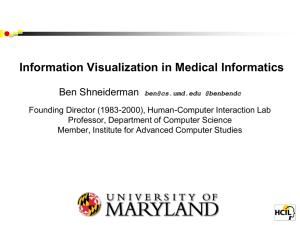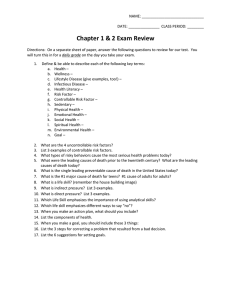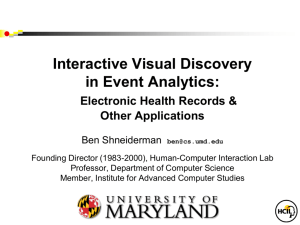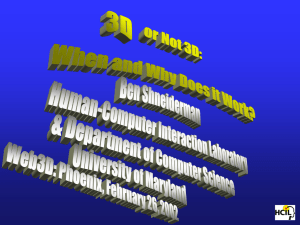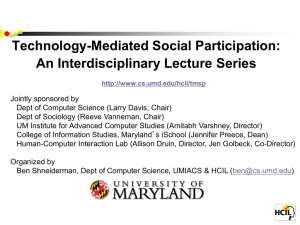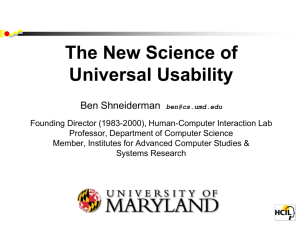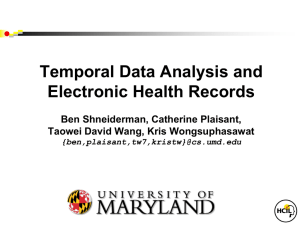The Future of the Web: Visual, Social, Universal Ben Shneiderman
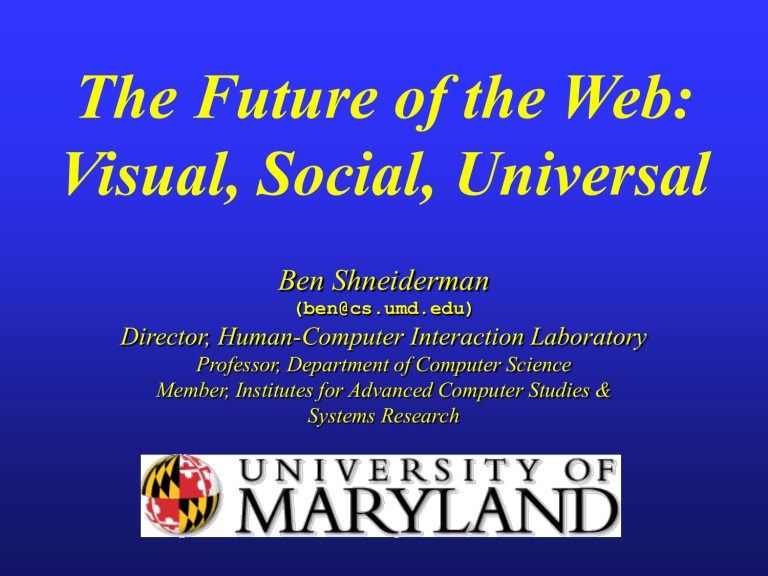
The Future of the Web:
Visual, Social, Universal
Ben Shneiderman
(ben@cs.umd.edu)
Director, Human-Computer Interaction Laboratory
Professor, Department of Computer Science
Member, Institutes for Advanced Computer Studies &
Systems Research
University of Maryland
College Park, MD 20742
Human-Computer Interaction Laboratory
Interdisciplinary research community
- Computer Science & Psychology
- Information Studies & Education www.cs.umd.edu/hcil
User Interface Design Goals
Cognitively comprehensible:
Consistent, predictable & controllable
Affectively acceptable:
Mastery, satisfaction & responsibility
NOT:
Adaptive, autonomous & anthropomorphic
User Interface Design Goals
Consistent
Predictable
Controllable
Cognitively comprehensible:
Consistent, predictable & controllable
Affectively acceptable:
Mastery, satisfaction & responsibility
NOT:
Adaptive, autonomous & anthropomorphic
Design Issues
Input devices & strategies
Keyboards, pointing devices, voice
Direct manipulation
Menus, forms, commands
Output devices & formats
Screens, windows, color, sound
Text, tables, graphics
Instructions, messages, help
Collaboration & communities
Manuals, tutorials, training www.awl.com/DTUI hcibib.org
usableweb.com
Scientific Approach (beyond user friendly)
Specify users and tasks
Predict and measure
time to learn
speed of performance
rate of human errors
human retention over time
Assess subjective satisfaction
(Questionnaire for User
Interaction Satisfaction 7.0, www.lap.umd.edu/QUIS/index.html)
Accommodate individual differences
Consider social, organizational & cultural context
U.S. Library of Congress
Scholars, Journalists, Citizens
Teachers, Students
Visible Human Explorer (NLM)
Doctors
Surgeons
Researchers
Students
NASA Environmental Data
Scientists
Farmers
Land planners
Students
U.S. Bureau of Census
Economists, Policy makers, Journalists
Teachers, Students
Web Design Strategies to Empower Users:
Visual, Social, Universal
1) Visual Design
Visual bandwidth is enormous
Human perceptual skills are remarkable
Trend, cluster, gap, outlier...
Color, size, shape, proximity...
Human image storage is fast and vast
Opportunities
Spatial layouts & coordination
Information visualization
Scientific visualization & simulation
Telepresence & augmented reality
Virtual environments
Consistent
Predictable
Controllable
Treemap - view large trees with node values
Space filling
Space limited
Color coding
Size coding
Requires learning
TreeViz (Mac, Johnson, 1992)
NBA-Tree(Sun, Turo, 1993)
Winsurfer (Teittinen, 1996)
Diskmapper (Windows, Micrologic)
Treemap97 (Windows, UMd)
Shneiderman, ACM Trans. on Graphics , 1992 www.cs.umd.edu/hcil/treemaps
Treemap - Stock market, clustered by industry
Temporal Info Viz - LifeLines
LifeLines
2) Social Support: Concepts
Online communities
E-commerce customer service & consumer conversations
Medical support groups & information exchange
Educational discussions & teamwork
Neighborhood forums & political organizing
Technologies
Synchronous text: Instant messaging, chat rooms
Asynchronous text: Listservs, bulletin boards, newsgroups
Audio,video, virtual realities
2) Social Support: Active Worlds
2) Social Support: Goals
Supporting Sociability
People: Target a population
Purposes: Clearly state focus
Policies: Make expectations explicit
behavior, privacy, moderation, joining rules
Consistent
Predictable
Controllable
Designing Usability
Users: Know the users
Tasks: Understand frequencies and sequences
Systems: Choose seamless combinations of tools
Online Communities: Supporting Sociability, Designing Usability
Jenny Preece, John Wiley & Sons, June 2000
Defining Trust
Trust is the expectation that arises within a community of regular, honest, and cooperative behavior, based on commonly shared norms, on the part of the members of that community.
- Francis Fukuyama, Trust , 1995
Trust indicates a positive belief about the perceived reliability of, dependability of, and confidence in a person, object, or process.
- B. J. Fogg, CHI99
Defining Trust - Revised
Trust is the positive expectation a person has for another person or organization that is based on past performance and truthful future guarantees
People rely on tools or processes
Person
Trusts
Rely on
Person
`
Tool
Process
Truthful
Future Guarantees
Responsible
Internet Design Credo
Empower individuals by clarifying responsibility
Promote participation by ensuring trust
2) Social Support: Trust
Invite participation by ensuring trust
Disclose patterns of past performance
Provide references from past and current users
Get certifications from third parties
Make policies for privacy & security easy to find & read
Accelerate action by clarifying responsibility
Clarify each participant's responsibilities
Provide clear guarantees with compensation
Describe dispute resolution and mediation services
Communications of the ACM, Dec. 2000, Special Issue on Trust
On-Web Deception and Trust
P.O. Box 83737
Bahamas
Make a Million in a
Month
We did it, you can too!
Invest now!
Type your credit card
#
_ _ _ _ _ _ _ _ _ _ _ _
On the web since 1993
Approved by SEC
Visit our 240 investment centers or online service assistants or call 1-800-TRUSTED
Over 80,000 customers - see their ratings and comments
Read our Customer Protection and Privacy Policy
Full money-back guarantee
3) Universal Usability Consistent
Predictable
Controllable
Technology variety :
Support broad range of hardware, software, and network access
User diversity :
Accommodate users with different skills, knowledge, age, gender, literacy, culture, income, disabilities, disabling conditions (mobility, injury, noise, light)...
Gaps in user knowledge :
Bridge the gap between what users know and what they need to know
Communications of the ACM , May 2000
Technology variety: Support broad range of hardware, software, and network access
1 to 100 range in processor speeds
286 486 Pentium
Device Independence
Input: keyboard, speech,...
Output: visual, auditory,...
Conversion: Text-speech
Speech-text,...
1 to 100 range in screen sizes
Palm devices Laptops Large Desktop or Wall Display
30,000 480,000 3,840,000 pixels
Software Versions
Compatibility
File conversion
Multiple platforms
1 to 100 range in network bandwidth
9.6K 56K 10,000Kbps
User diversity : Accommodate different users
Language & Culture
Western, Eastern, developing...
Personality
Introvert vs extravert
Thinking vs feeling
Risk aversion
Locus of control
Planful vs playful
Age
Disabilities
Visual, auditory, motoric, cognitive
Disabling conditions
Mobility, injury, noise, sunlight
Young to old
Skills
C omputer newbie to hacker
Gender
Male or Female
Knowledge
Income
Impoverished to wealthy
Domain novice to expert
Gaps in User Knowledge - Strategies
Bridge the gap between what users know and what they need to know
Design
Layered
Level-structured
Task-oriented
Online Learning
(evolutionary, phased)
Introductory tutorials
Getting started manuals,
Cue cards
Walkthroughs/Demos
Minimalist/Active
Training
Fade-able scaffolding
Training wheels
Minimalist
Online help
Context sensitive, tables of contents,
Indexes, Keyword search,
FAQs, Newsgroups, Chat rooms
Online communities
Customer service
Phone
Help desks
Thomas Jefferson
I feel... an ardent desire to see knowledge so disseminated through the mass of mankind that it may...reach even the extremes of society: beggars and kings.
-- Reply to American
Philosophical Society, 1808
Human-Computer Interaction Laboratory www.cs.umd.edu/hcil
